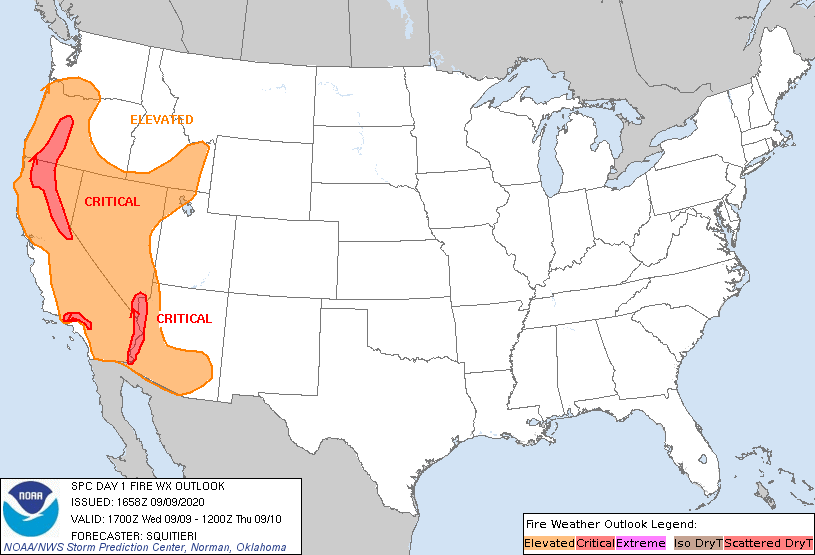Storm Prediction Center Day 1 Fire Weather Outlook
Created: Wed Sep 9 17:00:07 UTC 2020 (
![]() |
| ![]() )
)

|
Click for Day 1 FireWX Areal Outline Product
ZCZC SPCFWDDY1 ALL
FNUS21 KWNS 091658
Day 1 Fire Weather Outlook
NWS Storm Prediction Center Norman OK
1158 AM CDT Wed Sep 09 2020
Valid 091700Z - 101200Z
...CRITICAL FIRE WEATHER AREA FOR PARTS OF OREGON AND CALIFORNIA
ALONG THE WESTERN SLOPES OF THE CASCADES AND SIERRA...
...CRITICAL FIRE WEATHER AREA FOR PARTS OF SOUTHERN CALIFORNIA ALONG
THE TRANSVERSE RANGES...
...CRITICAL FIRE WEATHER AREA FOR PARTS OF THE LOWER COLORADO RIVER
VALLEY...ALONG THE CALIFORNIA...ARIZONA...NEVADA BORDER...
Portions of the southernmost Transverse Ranges in southern
California were removed from the Critical delineation. Some of the
latest METAR observations depict calming winds from the San
Bernardino Mountains southward, with high-resolution guidance
depicting subsiding winds into the afternoon. Clear skies (noted via
visible satellite) and resultant diurnal heating are contributing to
vigorous boundary-layer mixing across portions of the lower Colorado
River Valley. Latest METAR observations depict solidly critical
conditions ongoing, with 15-20% RH coinciding with 20-30 mph
sustained northerly winds. As such, no changes have been made to
this critical area. The critical area for the western slopes of the
Sierra/Cascades in California/Oregon has been maintained, as gusty
easterly winds may persist to the west of the higher terrain for at
least a couple more hours. Otherwise, Elevated criteria winds/RH may
occur across much of the western Great Basin westward with continued
boundary-layer-mixing, with no changes to the Elevated area made.
..Squitieri.. 09/09/2020
.PREV DISCUSSION... /ISSUED 0151 AM CDT Wed Sep 09 2020/
...Synopsis...
The strong offshore pressure gradient resulting from central Rockies
high pressure and West Coast low pressure will remain in place much
of the forecast period, though a weakening trend will commence late
in the day as the high weakens and shifts eastward toward the
central Plains. Meanwhile, subsidence aloft on the west side of a
cutoff low over the Four Corners area will continue to maintain a
very hot, dry airmass across much of the western states. The
overall pattern will maintain widespread elevated fire-weather
conditions along with a few areas of critical fire weather near
terrain-favored areas.
...Western Oregon into northern and central California...
Areas of critical fire-weather are likely to be ongoing at the
beginning of the forecast period amidst areas of poor recovery and
localized terrain-related forcing providing impetus for 20-30 mph
surface winds. The winds are likely to be strongest along the
Cascades and Sierras, where critical delineations remain in place.
Morning RH values in the 10-15% range will fall into the single
digits during the day in response to insolation and surface
temperatures rising into the low 90s F. These conditions, along
with near-record ERCs, will continue to exacerbate significant
issues with large ongoing fires exhibiting extreme behavior and
spotting. At this time, it appears that surface winds will begin to
weaken through the evening in response to a weakening surface
pressure gradient, which should limit critical fire-weather
conditions to localized areas of gusty winds - especially overnight.
...Coastal Ranges of southern California...
The aforementioned surface pressure gradient will encourage areas of
gusty winds (35-45 mph) in terrain-favored areas through mid-day.
These gusts will occur within a very dry airmass exhibiting poor
recovery, with 10-20% RH values falling into the 5-15% range as
insolation/surface warming commences. These conditions will combine
with dry fuels across the region to support continued, critical fire
weather. Again, surface winds should weaken from mid-day onward as
the surface pressure gradient diminishes and winds weaken.
...Lower Colorado River Valley...
Latest model guidance indicates a corridor of stronger surface winds
(with gusts exceeding 40 mph) continuing from early morning through
late evening amidst critically low RH values (around 15% in the
morning, falling to around 7-9% through the afternoon). The
corridor of strongest surface winds will correspond with terrain
along the Valley, where dry fuels beds will support rapid fire
spread with any ignitions. A critical fire-weather delineation has
been introduced in this outlook to address the threat.
...Please see www.spc.noaa.gov/fire for graphic product...